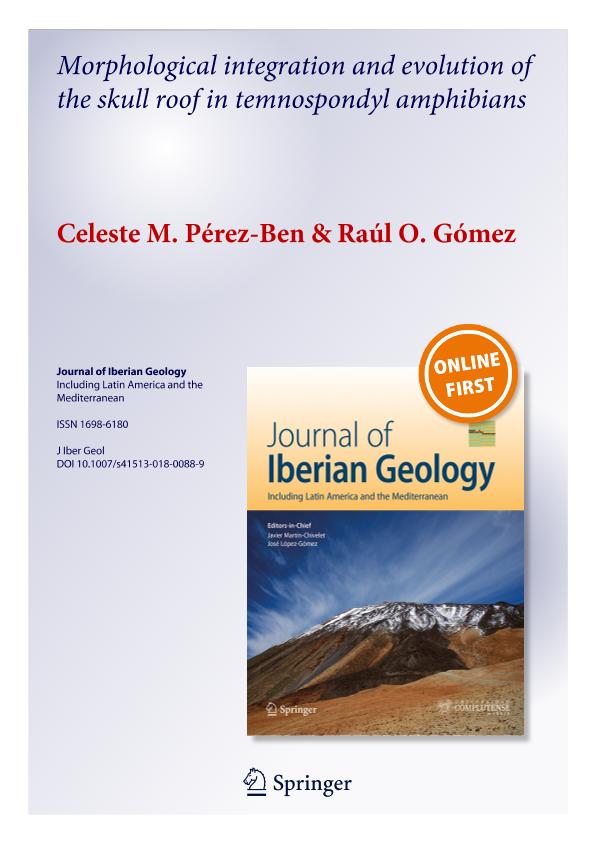Mostrar el registro sencillo del ítem
dc.contributor.author
Pérez Ben, Celeste Marina

dc.contributor.author
Gomez, Raul Orencio

dc.date.available
2022-07-08T19:39:51Z
dc.date.issued
2018-10
dc.identifier.citation
Pérez Ben, Celeste Marina; Gomez, Raul Orencio; Morphological integration and evolution of the skull roof in temnospondyl amphibians; Springer; Journal of Iberian Geology; 45; 10-2018; 341-351
dc.identifier.issn
1698-6180
dc.identifier.uri
http://hdl.handle.net/11336/161790
dc.description.abstract
Morphological integration refers to the phenotypic interdependence of two or more traits and is estimated by the degree of covariation or correlation among traits at different levels, such as at the intraspecific and evolutionary scales. Intraspecific integration of morphological traits results from the interaction among traits at the genetic, developmental, and functional levels and it has been proposed that it channels morphological evolution by modulating variability. In this work, we test whether the intraspecific integration might have channeled the morphological evolution of the skull roof in a major tetrapod radiation, that of extinct temnospondyl amphibians. To do this, we quantified the patterns of intraspecific integration of different species and explored their relationships with the evolutionary patterns of integration and disparity of three clades of temnospondyls using geometric morphometrics. We recovered that, at the intraspecific level, the integration patterns of the total shape of the skull roof are conserved across the clade and over geological time, but that the integration among individual bones varies in every species considered. We did not find a correlation between the patterns of integration among individual bones at the intraspecific and evolutionary levels, nor between the strength of intraspecific integration of each bone and their respective disparity. These results suggest that the intraspecific integration might have not affected significantly the morphological evolution of the skull roof in temnospondyls over geological time. Thus, it seems that the morphological evolution of this skeletal part might have been driven more by selective pressures than by shared developmental constraints inherited from the temnospondyl ancestor.
dc.description.abstract
La integración morfológica refiere a la interdependencia fenotípica de dos o más rasgos y es estimada por el grado de covariación o correlación de dichos rasgos a diferentes niveles, como el intraespecífico y el evolutivo. La integración intraespecífica de rasgos morfológicos resulta de la interacción de caracteres a nivel genético, del desarrollo y funcional y ha sido propuesta como canalizadora de la evolución morfológica al modular la variabilidad. En este trabajo, ponemos a prueba si la integración intraespecífica pudo haber canalizado la evolución morfológica del techo craneano en una de las grandes radiaciones de tetrápodos, la de los anfibios temnospóndilos extintos. Para ello, cuantificamos los patrones de integración intraespecífica de diferentes especies y exploramos su relación con los patrones evolutivos de integración y disparidad en tres clados de temnospóndilos usando morfometría geométrica. Obtuvimos que, a nivel intraespecífico, los patrones de integración de la forma total del techo craneano son conservados dentro del clado y a través del tiempo geológico, pero que la integración entre huesos individuales varía en todas las especies consideradas. No encontramos una correlación entre los patrones de integración entre los huesos individuales a nivel intraespecífico y evolutivo, ni entre la magnitud de la integración intraespecífica de cada hueso y su respectiva disparidad. Estos resultados sugieren que la integración intraespecífica pudo no haber afectado de manera significativa la evolución morfológica del techo craneano de los temnospóndilos a través del tiempo geológico. Por lo tanto, la evolución morfológica de esta parte del esqueleto habría sido dirigida en mayor medida por presiones selectivas que por restricciones del desarrollo heredadas del ancestro temnospóndilo.
dc.format
application/pdf
dc.language.iso
eng
dc.publisher
Springer

dc.rights
info:eu-repo/semantics/openAccess
dc.rights.uri
https://creativecommons.org/licenses/by-nc-sa/2.5/ar/
dc.subject
DISPARITY
dc.subject
MORPHOLOGICAL EVOLUTION
dc.subject
MORPHOLOGICAL INTEGRATION
dc.subject
TEMNOSPONDYLI
dc.subject.classification
Paleontología

dc.subject.classification
Ciencias de la Tierra y relacionadas con el Medio Ambiente

dc.subject.classification
CIENCIAS NATURALES Y EXACTAS

dc.title
Morphological integration and evolution of the skull roof in temnospondyl amphibians
dc.type
info:eu-repo/semantics/article
dc.type
info:ar-repo/semantics/artículo
dc.type
info:eu-repo/semantics/publishedVersion
dc.date.updated
2020-12-16T18:35:01Z
dc.identifier.eissn
1886-7995
dc.journal.number
45
dc.journal.pagination
341-351
dc.journal.pais
Alemania

dc.journal.ciudad
Berlín
dc.description.fil
Fil: Pérez Ben, Celeste Marina. Consejo Nacional de Investigaciones Científicas y Técnicas. Oficina de Coordinación Administrativa Ciudad Universitaria; Argentina. Universidad de Buenos Aires. Facultad de Ciencias Exactas y Naturales. Departamento de Ciencias Geológicas; Argentina
dc.description.fil
Fil: Gomez, Raul Orencio. Consejo Nacional de Investigaciones Científicas y Técnicas. Oficina de Coordinación Administrativa Ciudad Universitaria; Argentina. Universidad de Buenos Aires. Facultad de Ciencias Exactas y Naturales. Departamento de Biodiversidad y Biología Experimental; Argentina
dc.journal.title
Journal of Iberian Geology

dc.relation.alternativeid
info:eu-repo/semantics/altIdentifier/url/http://link.springer.com/10.1007/s41513-018-0088-9
dc.relation.alternativeid
info:eu-repo/semantics/altIdentifier/doi/https://doi.org/10.1007/s41513-018-0088-9
Archivos asociados
